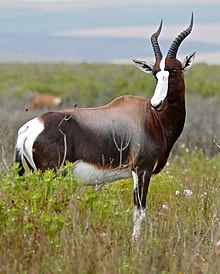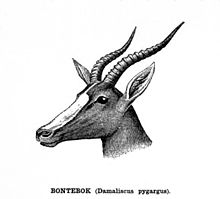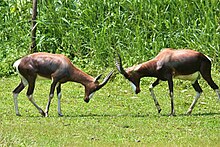Bontebok
| Bontebok | |
|---|---|
 | |
| Bontebok in Bontebok National Park, South Africa. | |
Conservation status | |
CITES Appendix II (CITES)[2] | |
| Scientific classification | |
| Domain: | Eukaryota |
| Kingdom: | Animalia |
| Phylum: | Chordata |
| Class: | Mammalia |
| Order: | Artiodactyla |
| Family: | Bovidae |
| Subfamily: | Alcelaphinae |
| Genus: | Damaliscus |
| Species: | D. pygargus |
| Binomial name | |
| Damaliscus pygargus (Pallas, 1767) | |
| Subspecies | |
| |
The bontebok (Damaliscus pygargus) is an antelope found in South Africa, Lesotho and Namibia. D. pygargus has two subspecies; the nominate subspecies (D. p. pygargus),[3] occurring naturally in the Fynbos and Renosterveld areas of the Western Cape, and the blesbok (D. p. phillipsi) occurring in the Highveld.
The bontebok is related to the common tsessebe.
Description

The bontebok is a tall, medium-sized antelope. They typically stand 80 to 100 cm (31 to 39 in) high at the shoulder and measure 120 to 210 cm (47 to 83 in) along the head and body. The tail can range from 30 to 60 cm (12 to 24 in). Body mass can vary from 50 to 155 kg (110 to 342 lb). Males are slightly larger and noticeably heavier than females.[4] The bontebok is a chocolate brown colour, with a white underside and a white stripe from the forehead to the tip of the nose, although there is a brown stripe across the white near the eyes in most blesbok. The bontebok also has a distinctive white patch around its tail (hence the Latin name), while this patch is light brown/tan in the blesbok. The horns of the bontebok are lyre-shaped and clearly ringed. They are found in both sexes and can reach a length of half a metre.
Habitat
Blesbok live in the Highveld, where they eat short grasses, while bontebok are restricted to the coastal Fynbos and the Renosterveld.[5] They are diurnal, though they rest during the heat of the day. Herds contain only males, only females, or are mixed, and do not exceed 40 animals for bontebok or 70 for blesbok.

Behavior

Bontebok are not good jumpers, but they are very good at crawling under things. Mature males form territories and face down other males in displays and occasionally fight them.
Conservation
Bontebok were once extensively killed as pests, and by the early 20th century were reduced to a wild population of just 17 individuals. The species was saved from certain extinction when Dutch farmer Alexander van der Bijl corralled the remaining individuals into a fence, which they were unable to jump out of. In 1931, this herd of 17 was transferred to Bontebok National Park, which was established for the explicit purpose of conservation of the species. By the time the park was relocated to better suit the needs of the bontebok in 1961, the herd had grown to 61 members. Today, their population is estimated to range from 2,500 to 3,000, all descendants of the original herd of 17 members.[6]
While Bontebok are extinct in their natural habitat, they have increased in population to the point where they are now very abundant and avidly farmed, because they are popular quarry for hunters and are easy to sustain.
In culture
The bontebok is the provincial animal of Western Cape.[7]
References
 Data related to Damaliscus pygargus at Wikispecies
Data related to Damaliscus pygargus at Wikispecies
- ^ "Battle of 1852". IUCN Red List of Threatened Species.
- ^ "Appendices | CITES". cites.org. Retrieved 2022-01-14.
- ^ Wilson, D. E.; Reeder, D. M., eds. (2005). Mammal Species of the World: A Taxonomic and Geographic Reference (3rd ed.). Johns Hopkins University Press. ISBN 978-0-8018-8221-0. OCLC 62265494.
- ^ Burnie, D. and Wilson, D.E. (eds.), Animal: The Definitive Visual Guide to the World's Wildlife. DK Adult (2005), ISBN 0789477645
- ^ (Skead, 1980)
- ^ "Bontebok Can't Jump: The Most Dramatic Conservation Success You've Never Heard About". 8 July 2015. Archived from the original on 2022-04-27.
- ^ "Symbols of the Province of the Western Cape" (PDF). Archived (PDF) from the original on 2020-04-30.
- Skead, C.J., 1980. Historical mammal incidence in the Cape Province Volume 1. The Department of Nature and Environmental Conservation of the Provincial Administration of the Cape of Good Hope, Cape Town.

- v
- t
- e
- Kingdom: Animalia
- Phylum: Chordata
- Class: Mammalia
- Infraclass: Eutheria
- Superorder: Laurasiatheria
Suborder Ruminantia | |||||||||||||||||||||||||||
|---|---|---|---|---|---|---|---|---|---|---|---|---|---|---|---|---|---|---|---|---|---|---|---|---|---|---|---|
| |||||||||||||||||||||||||||
Family Cervidae | |||||||||||||||||||||||||||||||||||||||||||
|---|---|---|---|---|---|---|---|---|---|---|---|---|---|---|---|---|---|---|---|---|---|---|---|---|---|---|---|---|---|---|---|---|---|---|---|---|---|---|---|---|---|---|---|
| |||||||||||||||||||||||||||||||||||||||||||
Family Bovidae | |||||||||||||||||||||||||||||||||||||||||||
|---|---|---|---|---|---|---|---|---|---|---|---|---|---|---|---|---|---|---|---|---|---|---|---|---|---|---|---|---|---|---|---|---|---|---|---|---|---|---|---|---|---|---|---|
| |||||||||||||||||||||||||||||||||||||||||||
| |||||||||||||||||||||||||||
| |||||||||||||||||||||||
Family Bovidae (subfamily Antilopinae) | |||||||||||||||||||||||||||||||||||||||||||||||
|---|---|---|---|---|---|---|---|---|---|---|---|---|---|---|---|---|---|---|---|---|---|---|---|---|---|---|---|---|---|---|---|---|---|---|---|---|---|---|---|---|---|---|---|---|---|---|---|
| |||||||||||||||||||||||||||||||||||||||||||||||
Suborder Suina | |||||||||||||||||||||||
|---|---|---|---|---|---|---|---|---|---|---|---|---|---|---|---|---|---|---|---|---|---|---|---|
| |||||||||||||||||||||||
Suborder Tylopoda | |||||||
|---|---|---|---|---|---|---|---|
| |||||||
Suborder Whippomorpha | |||||||||
|---|---|---|---|---|---|---|---|---|---|
| |||||||||











